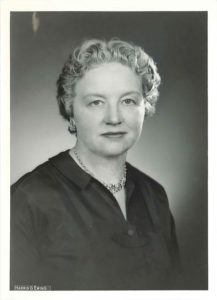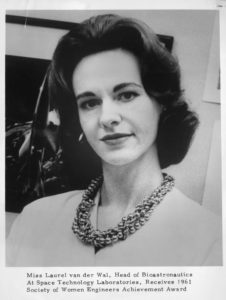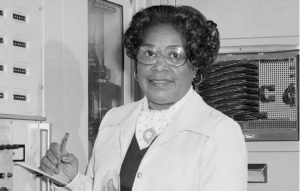In our fourth installment of The Women Who Have Shaped Space Exploration series, we focus on four women who have revolutionized the industry and are notable for laying essential processes and frameworks in various areas of the space and aeronautics industry.

Dr. Eilene Galloway
Nicknamed the Grand Dame of Space, Dr. Eilene Galloway was an American researcher and editor and is often cited as “an influential force in the development and analysis of global space law and policy.” In particular, she spearheaded and made international space cooperation an ongoing possibility and is solely responsible for the section on international cooperation in the National Aeronautics and Space Act, signed by President Dwight D. Eisenhower in 1958.
Born in Kansas City, Missouri, Dr. Galloway began her work with the Congressional Research Service in the Library of Congress in 1941. She worked as the editor for the Space Law Senate Symposium, and served for several decades on the United Nations Committee on the Peaceful Uses of Outer Space. While working for the United States Senate and House of Representatives, she wrote many essays, including “Guided Missiles in Foreign Countries” in 1957 and then a report on the Sputnik 1 launch, the first artificial satellite and its impact on the United States.
By the 1960s, Eilene Galloway represented the United States in drafting treaties that governed the exploration and use of outer space, contributing to the launch of the field of International Space Law. Dr. Galloway also played an influential role in the founding of the Agency for the American Space Exploration and is an establishing member of the International Institute of Space Law (IISL), an independent non-governmental organization dedicated to supporting the development of space law. She served as vice-president of the Institute between 1967 and 1979, becoming the Institute’s honorary director.
Dr. Galloway received the Andrew Haley Gold Medal in 1968, and the Lifetime Achievement Award from IISL in 1990. In 1984, Galloway received the NASA Public Service Award for her excellence as a congressional advisor on the technical and legal aspects of outer space, and her service to the United Nations and other international organizations. In 1987, she was honored as the first recipient of the Women in Aerospace Award of Excellence. Today, she is recognized by her peers as one of the greatest experts in her field.

Laurel van der Wal
An American aeronautical engineer, Laurel van der Wal is known for her contributions to bioastronautics. While still in the early phase of her engineering career, she worked as a data analyst on the Nike missile program at Douglas Aircraft. Later, van der Wal designed missile systems for the Ramo-Wooldridge Corporation. In 1958, she became the project engineer on three MIA launches from Cape Canaveral as head of the bioastronautics at Space Technology labs. In 1960, van der Wal was named the Women of the Year in Science by the Los Angeles Times. The next year, she won the Society of Women Engineers Achievement Award for her contributions to bioengineering and bioastronautics for several projects, including Project MIA, which studied the psychological effects of U.S. space flight. She also focused on the design of human-crewed spacecraft along with escape and recovery systems for astronauts.
That same year, Van der Wal became the first woman to sit on the Los Angeles Board of Airport Commissioners. She then served as a commissioner until 1967. In 1968, she became a planner for the Los Angeles International Airport.
Notably, Laurel van der Wal became director of the Southern California chapter of the American Rocket Society. In this position, she took an active interest in partnering with Explorer Scouts to teach children about space and aeronautics.
As the space program gained popularity with mainstream Americans in the 1960s, van der Wal became a guest speaker at numerous events. In 1968, she noted that the children she taught were “the most important thing ever to happen to me, ever.”
By the early 1970s, she wrote several reports for the Rand Corporation about creating more effective transportation systems.

Dorothy Vaughan
Dorothy Vaughan earned well-deserved recognition in recent years for her portrayal by Octavia Spencer as one of the women who helped win America’s space race in the Academy Award-nominated film, Hidden Figures. Vaughan is recognized for her role as an American mathematician and human computer for the National Advisory Committee for Aeronautics (NACA), and NASA and her work on the Scout Launch Vehicle Program.
In 1943, she began her career as a mathematician and programmer at Langley Research Center in Virginia, where she became an expert in calculations for flight plans, the Scout Project and computer programming. At the time, she had to endure racism and bias as one of a handful of African-American women assigned to a segregated unit, the West Computers. Here, they did all the mathematics by hand. They eventually made major contributions to every area of Langley’s research and supported design for the United States space programs. In 1949, she became the lead supervisor of the West Area Computers, marking the first African-American woman to supervise staff members at the Langley Research Center. Vaughan was later promoted to supervisor and fought for opportunities for women in West computing as well as women in other departments.
In her 28-year career, Vaughan taught herself electric computing with the programming language FORTRAN. She then later taught it to her staff to prepare for the introduction of machine computers to the center in the early 1960s.
When NACA transformed into NASA, segregated facilities like the West Computing office were abolished. In a later interview, Vaughan stated that working at Langley during the space race felt like being on “the cutting edge of something very exciting.” She also commented on being an African American woman during that time: “I changed what I could, and what I couldn’t, I endured.”
She later led the programming section of the Analysis and Computation Division (ACD) at Langley throughout the 1960s and had many of her former West Computers join, an integrated group on the forefront of electronic computing.
In 2019, Dorothy Vaughan was posthumously awarded the Congressional Gold Medal.






